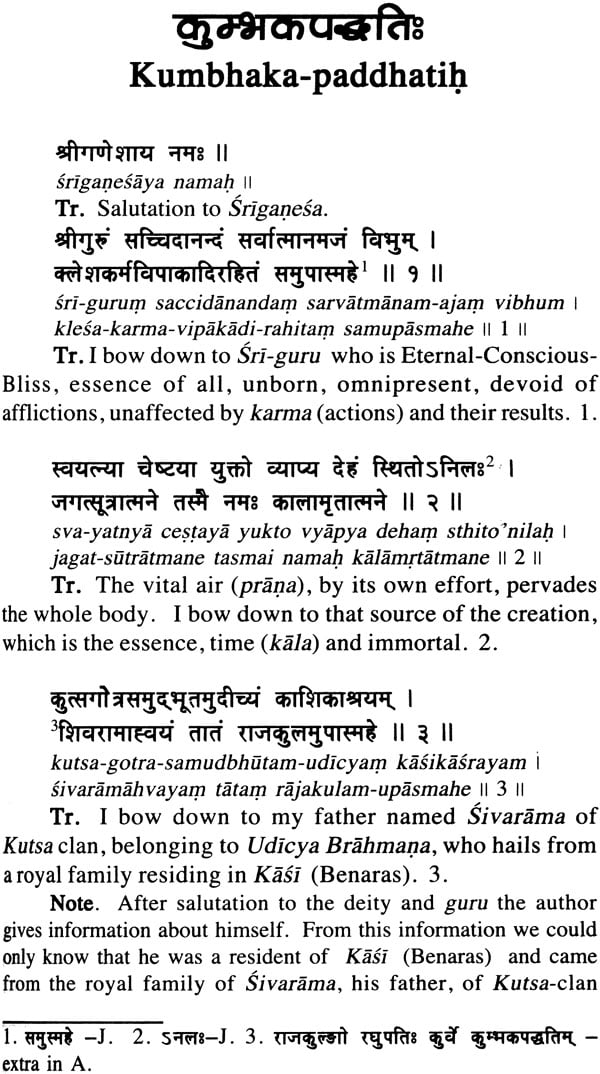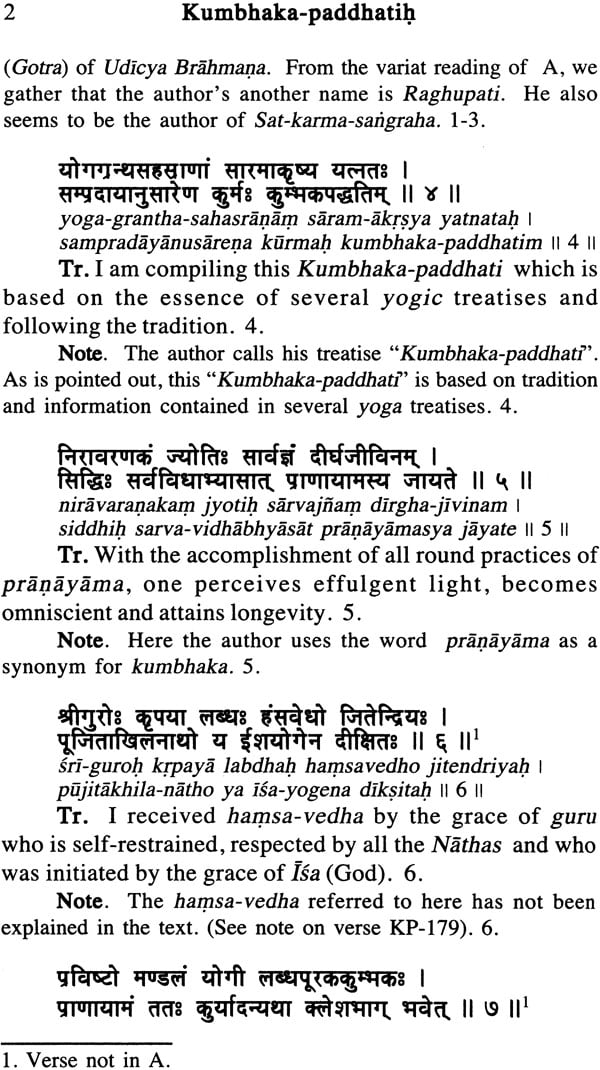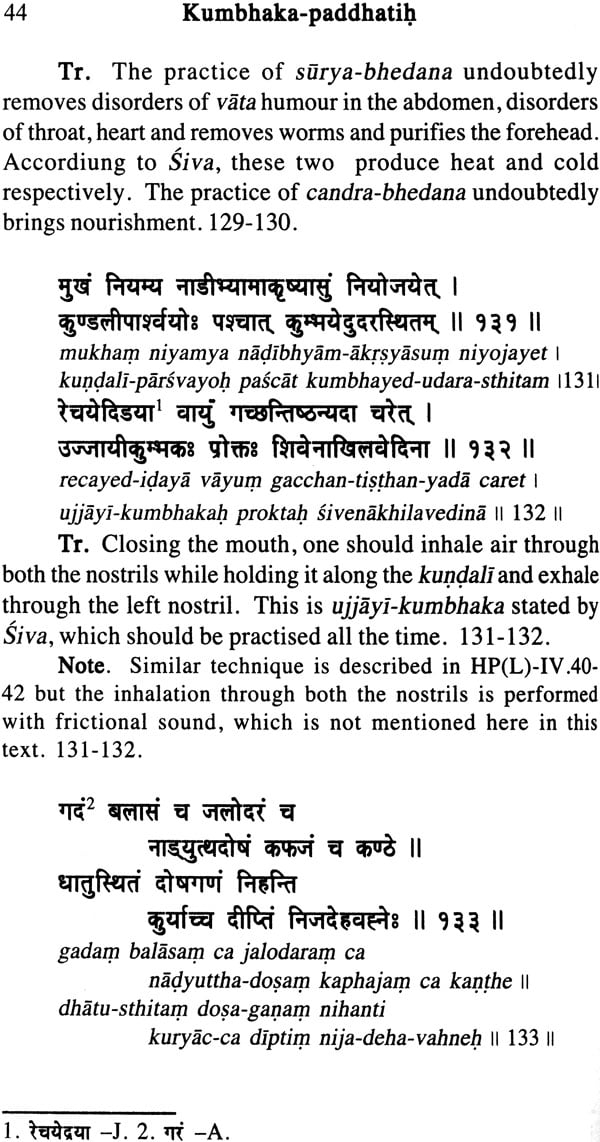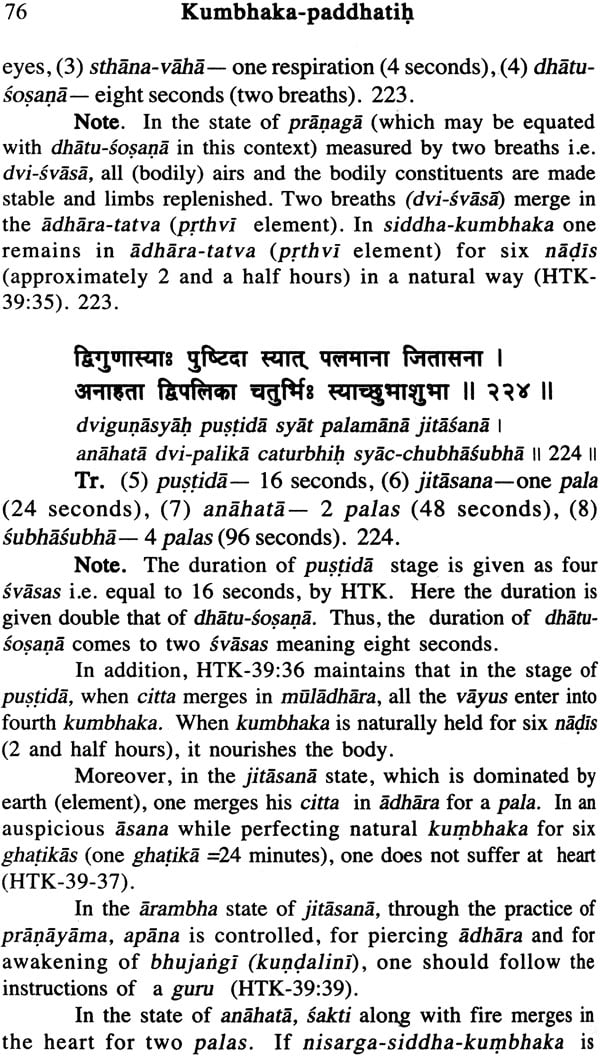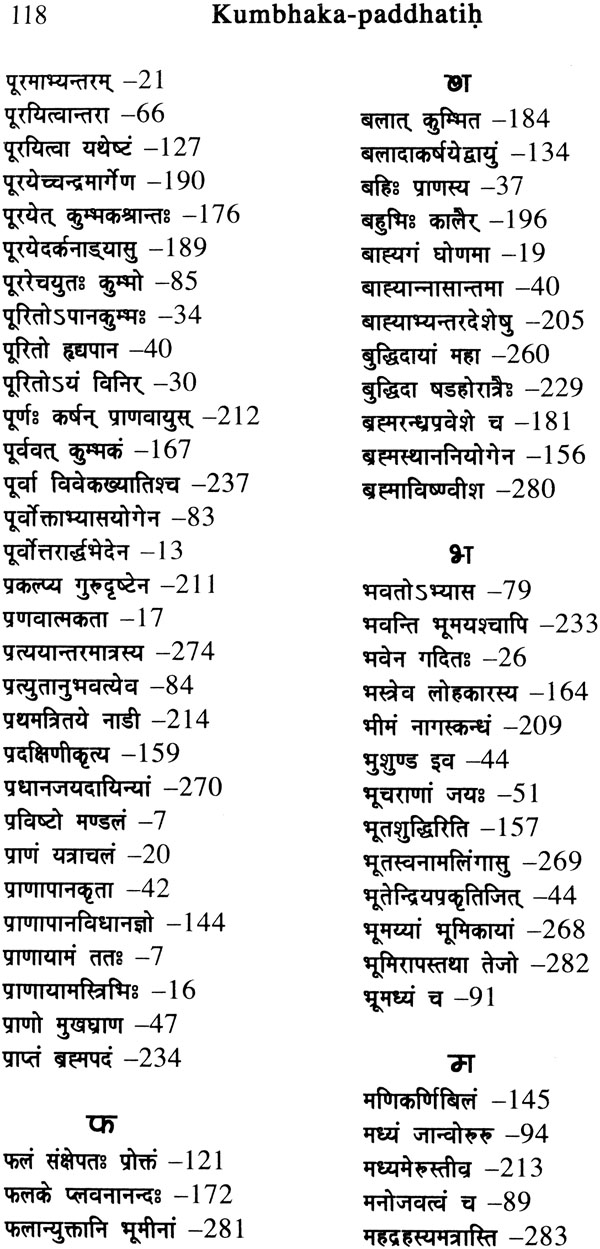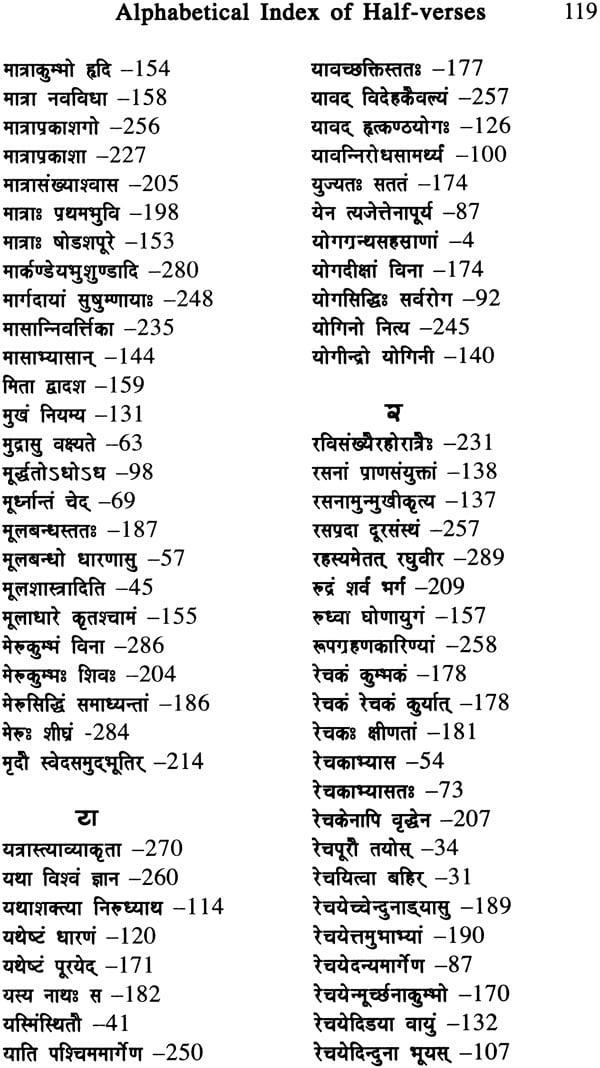
Kumbhaka - Paddhati (Science of Pranayama)
Book Specification
| Item Code: | NAM746 |
| Author: | Dr. M. L. Gharote and Dr. Parimal Devnath |
| Publisher: | The Lonavla Yoga Institute, Lonavla |
| Language: | Sanskrit Text With Transliteration and English Translation |
| Edition: | 2021 |
| ISBN: | 8190117653 |
| Pages: | 195 |
| Cover: | Paperback |
| Other Details | 8.5 inch x 5.5 inch |
| Weight | 200 gm |
Book Description
Kumbhaka Paddhati is the only text which deals exhaustively the topic of pranayama. It is extensively quoted by Sunderadeva , another writer on hatha-yoga in his Hatha-sanketa-candrika and Hatha-tatva- kaumudi . The text describes more than 50 kumbhakas, many of which are not commonly known. Despite the description of various kurnbhakas , the author is loud in praise for meru-kumbhaka of which he describes 47 stages. These include all levels of spiritual development. These stages are a continuum of experiences the yogi passes through as a result of continuous-practice. of kumbhakas. These are not found described in any. available texts. Therefore. it is the unique feature of .Kumbhaka Paddhati .
Kumbhaka-paddhati (manual on pranayama) of Sri Raghuvira, edited by Dr. M. L. Gharote and Dr. Parimal Devnath is an interesting collection on the science of pranayama.
yoga-cudamani-upanisad mentions pranayama vidya as mahavidya (great knowledge of learning), where the practitioner of pranayama experiences the union of himself with the Universal Spirit (Brahma).
Kumbhaka-paddhati explains fifty-seven types of kumbhaka with forty-seven stages.
God is one, but people call him by different names. Similarly, though the text explains fifty-seven types of kumbhakas, the readers should know that the principal kumbhakas are of these types namely, antar-kumbhaka (retention of breath after inhalation), bahya-kumbhaka (retention of breath after exhalation), kumbhaka in-between interrupted puraka and recaka and one that is both instinctive and intuitive (kevala-kumbhaka).
Actually, pranayama consists of four movements: puraka (in-breath), antar-kumbhaka (retention after breath), recaka (out-breath) and bahya-kumbhaka (retention of breath after the out-breath).
As different patterns of breathing and retention can be discovered while performing different types of asanas, it is possible to adopt and adapt different types of breathing patterns and retention (kumbhaka), according to one' internal intellectual development and maturity. These adoptions and adaptations through the various permutations and combinations express the multiples of kumbhakas.
As Pranava 'aum' with the crescent and dot is the seed of all words, puraka represents generation or creation of energy (G) Brahma, antar-kumbhaka represents organization of energy (0) Visnu, recaka releases that vitious air that destroys life (D) Mahesvare, while bahya-kumbhaka takes one to experience the changeless, eternal state of quietude.
Pranayama is a great penance (maha tapas). It is nadanusandhana, one has to investigate, inquire and search (sravana, manana and nididhyasana). Lord Patanjali puts this in simple words, japa, artha and bhavana.
We have all been bestowed with pance-bhautike-serira consisting of earth, water, air and ether. They are the physical matters of the body. These five matters have their own infrastructures as panca tenmatras, namely, odour, taste, shape, touch and space. These tanmatras are the chemistry and alchemy of the body. These are controlled by the cosmic life force (visva-prana-sakti). As nature (Prakrti) divides into various sections, this visva-prana-sakti transforms into panca vayus as prana, apana, samana, vyana and udana. These five vayu's locations have been explained in the text corresponding to the five elements and their corresponding five atomic powers. They also correspond to the five cakras namely, muladhara, svadhisthana, manipuraka, anahata and visuddhi. The other two cakras, ajna and sahasrara are beyond matter.
These pance-vayus churn, mix, mould and blend the bhutas and tanmatras to bring their essence (rasa) and prana sakti (elixir of life).
We are endowed with karana-sarira (causal body), suksma-sarira (subtle body) and sthula-sarira (gross body, also called karya-sarira).
These three bodies represent the prajna (awareness) of self, consciousness and body (asmita, citta, desa) and prana acts as the link in connecting these three bodies. For example, inhalation helps in expanding the self and consciousness progressively in delicate adjustment to touch the torso (desa) , whereas in exhalation, the sense and feel of the body and consciousness is gradually released to reach the self without any disturbance or collapse in the outer body. In kumbhaka equi-balance of prana and apana is learnt. This way pranayama sadhana acts as a hub for the sadhaka to learn this connection with clarity.
In short, the secret of pranayama is the art of spacing the intelligence of the self, judiciously in the body (desa) , by puraka. Uniting together the space in place is antar- kumbhaka. Releasing the breath delicately for the place to reach the inner space is recaka, bringing together the place with the interior space of the body is bahya-kumbhaka. Hence, pranayama is not only a method of balancing the energy metabolism, but it also is an experiencing the state of composed consciousness (samadhana-citta).
Kumbhaka-paddhati cautions that, 'as one climbs from the lower steps to reach the top of the ladder, one has to progress in kumbhaka, carefully observing the rules and stages of pranayama to reach the higher stages of yoga' (KP-231- 236). The effects of kumbhaka explained from 237 to 280 in this treatise are also found in the vibhuti-pada of Patanjali and hathayoge texts.
The notes given at the end of the book are a guide for sadhakas.
I feel that it is a valuable book for keen pranayama sadhakas and it is a well presented book to know and understand the richness of the science, art and philosophy of pranayama.
The work of editing the present text of Kumbhaka- paddhati was started with the single manuscript available in the beginning. This manuscript is deposited in the Rajasthan Oriental Research Institute, Jodhpur the details of which are as follows-
Ace. No. 4577, Kumbhaka-paddhati by Raghuvira. Size 24.0x 11.3 cm., lines 10, letters 28, folio No. 21, status - complete, condition good, age 19th century.
This is indicated as 'J'.
As the work proceeded we found the quotations from Kumbhaka-paddhati in the works like HSC and HTK, both composed by Sundaradeva. For comparison and variant readings, these quotations from Kumbhaka-paddhati were considered. When the text was almost completed, we came to know that another manuscript copy of Kumbhaka-paddhati is deposited in the Library of Asiatic Society, Kolkata, through our friend Dr. Dhanaraj Sharma, Prof. of Sanskrit Deptt., Punjab University, Chandigarh. He was kind enough to send us a Xerox copy of this manuscript for our study. We are grateful to him for his friendly gesture in the interest of yoga. The details of this manuscript are as follows-
Acc. No. viii.B.6597 ,Royal Asiatic Society of Bengal, Kolkata, Kumbhaka-paddhati by Raghuvira Audicya, I.M.499.
Size 22.5x9.3 cm., lines 5, letters 8-11, folio No. 31, status complete, condition good.
This is indicated as 'A'.
'J' manuscript is more complete. There are many verses missing in 'A' manuscript. However, 'A' manuscript has been used for determining important readings.
It is interesting to note that' A' manuscript has been noted in the Aufrecht's Catalogus and in Catalogus Catalogrum. But the 'J' manuscript has not been included. We find the' J' manuscript important and therefore it is used as vulgate.
The author of Kumbhaka-paddhati
The author of Kumbhaka-paddhati is Raghuvira. He is also mentioned as Raghava, Raghupati and Raghurama. He has given a brief account of himself in the beginning of the text from which we know that his father Siverama hailed from a royal family and was residing in Kasi (Benares). He was a descendent of Kutsa Gotra (clan) and was an Udicya Brahmana.
Kaivalyadhama, Lonavla, has published a text called 'Satkarma-samgraha' edited by Dr. R. G. Harshe in 1970. In this text verse no. 148 states-
iti sanksepatah proktsh karmanam sangrahah ptuuh|
vidusa raghuvirena sriman-natha-prasadatah.||
This ascribes its authorship to Raghuvira, Raghava or Raghunatha. In verse no. 149 there is a reference to Audicya Brehmana- 'iti srimad-dvijodicya-jnati- rajakulabhidhat'. From these statements it is clear that Raghava or Raghuvira has also written the above text of Satkarma-samgrahah.
There are many similarities in his writings in both of these texts which may be mentioned below:
i) There are frequent references to the sources of Siva found in both the texts. Every now and then the author has expressed his indebtedness to Siva using several of Siva's synonyms.
ii) He calls himself an Audicya Brebmana and descendent of a royal family.
iii) He calls his treatise on a particular subject as 'paddhati' like 'Karma-paddhati' and 'Kumbhaka-paddhati'.
The text of Satkarma-samgraba apparently seems to have been written by 'cidghananandanatha' - 'cidghananandanatha 'ham kurve satkarma-sangraham.' It is possible that this name has been adopted by Raghuvira or Raghava prior to writing of the 'Satkarma-sangraha' as suggested by the editor of this text. He calls himself as the disciple of Gaganananda-natha. Raghava seems to have written another text named 'Misraka' having an admixture of yoga and medicine as the title indicates.
We come across quotations from KP in the works like Hathasanketa-candrika and Hatha-tatva-kaumudi authored by Sundaradeva.
Both Raghuvira and Sundaradeva were residing in Kasi. But it is not known whether they were contemporaries.
The title of the text
The title of the text given by the author is Kumbhaka- paddhati. He also refers to kumbhamarga or the path of kumbhaka originated from Siva. Kumbhaka-paddhati and kumbhamarga may be considered as synonyms.
What is kumbhaka?
The word kumbhaka is derived from the word kumbha meaning a water pot. Just as a water pot contains water, similarly, when the lungs hold the air, it is called kumbhaka. Yoga-yajnyavalkye defines kumbhaka as 'sampurna- kumbhavad-vayor-dharanam kumbhako bhavet'. Kumbha is used for kumbhaka in many places in the present text. kumbhaka is also a synonym of pranayama and has been profusely used in the pauranika and hathayogic literature. In these texts, the technique of pranayama is described in three phases, namely, paraka, kumbhaka and recaka. But in pranayama the phase of kumbhaka is most important and puraka and recaka are only complementary and supplementary phases. Looking to the importance of the kumbhaka phase, it is considered as a synonym for pranayama. Thus the three phases of pranayama, namely, puraka, kumbhaka and recaka are respectively the processes of filling the lungs with air, holding the air in the lungs and expelling the air from the lungs.
In the phase of kumbhaka, there is no movement of breath. Therefore, smrtis define it as niscala-svasah. It is a phase in the respiration technically described as svasa- prasvasa-gati- vicchedah (PYS- II.49).
Physiology of kumbhaka
Kumbhaka may be physiologically described as Breath Holding. The term Breath Holding occurs frequently in the Sports literature. In many athletic events breath is held. The physiology of breath holding involves respiratory, circulatory and cardiac changes, all of which are important. Most obvious changes are increasing level of CO2 and decreasing level of 02 in the alveolar air. These changes reflect the changes in the level of respiratory gases in the blood. 02 and CO2 levels are involved in respiratory control, but CO2 level is more important in holding the breath.
When the partial pressure of CO2 in the alveolar air exceeds approximately 50mrn.Hg., the stimulus to breathe is so strong that the breath can no longer be held. This is called Break Point at which breathing recommences.
Chemoreceptors are susceptible to chemical component of the blood. Due to accumulation of CO2, the capacity to retain the breath is limited. According to Haldane .01 per cent change in CO2 changes the action of the respiratory system.
In kumbhaka afferent impulses of Vagus start from the lungs and the efferent impulses of Vagus are sent back from Medulla oblongata. The afferent impulses enable us to keep the lungs in a particular stretched position and the efferent impulses help to slow down the heart.
| Foreword | ix |
| Publisher's Note | xiii |
| Scheme of Transliteration | xvi |
| Abbreviations | xix |
| Detailed Contents | xxi |
| Introduction | xxix-lxx |
| Text, Transliteration, Translation, | |
| Critical Notes and Foot Notes | 1-97 |
| Appendices i, ii & iii | 98-100 |
| Glossary | 101-108 |
| Word Index | 109-112 |
| Alphabetical Index of half-verses | 113-122 |
